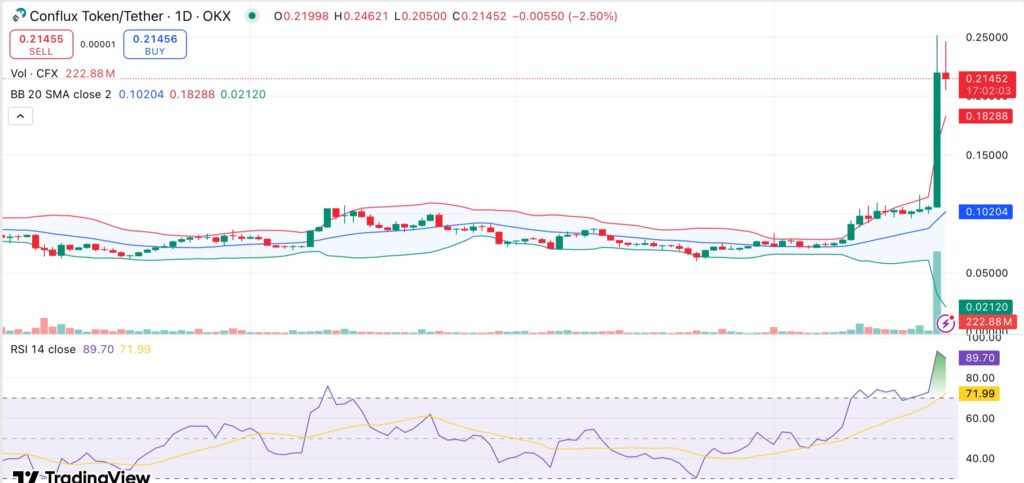CFX jumps 70% following Conflux 3.0 upgrade announcement
Conflux jumped about 70% from around $0.1450 to a local high of $0.2416 on July 21, as momentum accelerated following the announcement of its Conflux 3.0 upgrade.
The rally, which gained steam after the network’s Shanghai ecosystem conference concluded on July 20, has pushed Conflux ( CFX ) to a one-month gain of over 200% and a seven-day rise of approximately 104%.
Along with the recent breakout, the token’s market capitalization now stands at $1.12 billion, having reclaimed the $1 billion mark. Even after this rebound, CFX is still almost 87% below its peak of $1.70, which was reached in March 2021.
Trading activity has surged alongside the price. Spot trading volume is up 792%, surpassing $1.7 billion. According to Coinglass data , 24-hour derivatives volume has soared as well. It rose 981% to $6.44 billion, while open interest rose 241% to $350.66 million. These increases point to a sharp uptick in speculative positioning, potentially increasing short-term volatility.
The planned Conflux 3.0 upgrade, scheduled for July 31, will introduce the Tree-Graph consensus mechanism, enabling parallel processing of transactions and blocks. This modification is expected to greatly improve network scalability, increasing throughput to over 15,000 transactions per second.
The update will also allow developers to invoke AI agents on-chain, making Conflux one of the first major networks to incorporate AI directly into its smart contract layer. This aligns the protocol with one of the fastest growing technology trends.
In addition, Conflux is building the necessary infrastructure to support tokenized real-world assets and blockchain-based cross-border trade, including a proposed offshore Chinese yuan stablecoin . If successful, it could help China reach its long-term goal of internationalizing its currency through digital rails.
Looking at the technical picture, CFX has broken significantly above the upper Bollinger Band, reflecting the magnitude of the recent upward momentum. A short retracement might be on the horizon given that the relative strength index is at 89.70, well into overbought territory..
 Conflux price analysis. Credit: crypto.news
Conflux price analysis. Credit: crypto.news
However, the larger trend is still in place as all of the major moving averages, alongside the 10-200 day EMAs and SMAs, are flashing bullish signals. Volume and momentum indicators are still high, and the MACD is also in buy territory.
The token may attempt another leg higher if CFX maintains above-key support and sentiment regarding the update and AI integration remains positive. A move toward the $0.30–$0.35 range would be possible with a confirmed breakout above $0.25, but this would likely require fresh catalysts or broader market tailwinds.
If CFX is unable to hold above recent highs, a pullback toward the $0.18–$0.20 range is possible, particularly if profit-taking accelerates. A breakdown below that region might expose the $0.15 level.
Disclaimer: The content of this article solely reflects the author's opinion and does not represent the platform in any capacity. This article is not intended to serve as a reference for making investment decisions.
You may also like
After bitcoin returns to $90,000, is Christmas or a Christmas crash coming next?
This Thanksgiving, we are grateful for bitcoin returning to $90,000.

Bitcoin security reaches a historic high, but miner revenue drops to a historic low. Where will mining companies find new sources of income?
The current paradox of the Bitcoin network is particularly striking: while the protocol layer has never been more secure due to high hash power, the underlying mining industry is facing pressure from capital liquidation and consolidation.

What are the privacy messaging apps Session and SimpleX donated by Vitalik?
Why did Vitalik take action? From content encryption to metadata privacy.

The covert war escalates: Hyperliquid faces a "kamikaze" attack, but the real battle may have just begun
The attacker incurred a loss of 3 million in a "suicidal" attack, but may have achieved breakeven through external hedging. This appears more like a low-cost "stress test" targeting the protocol's defensive capabilities.

